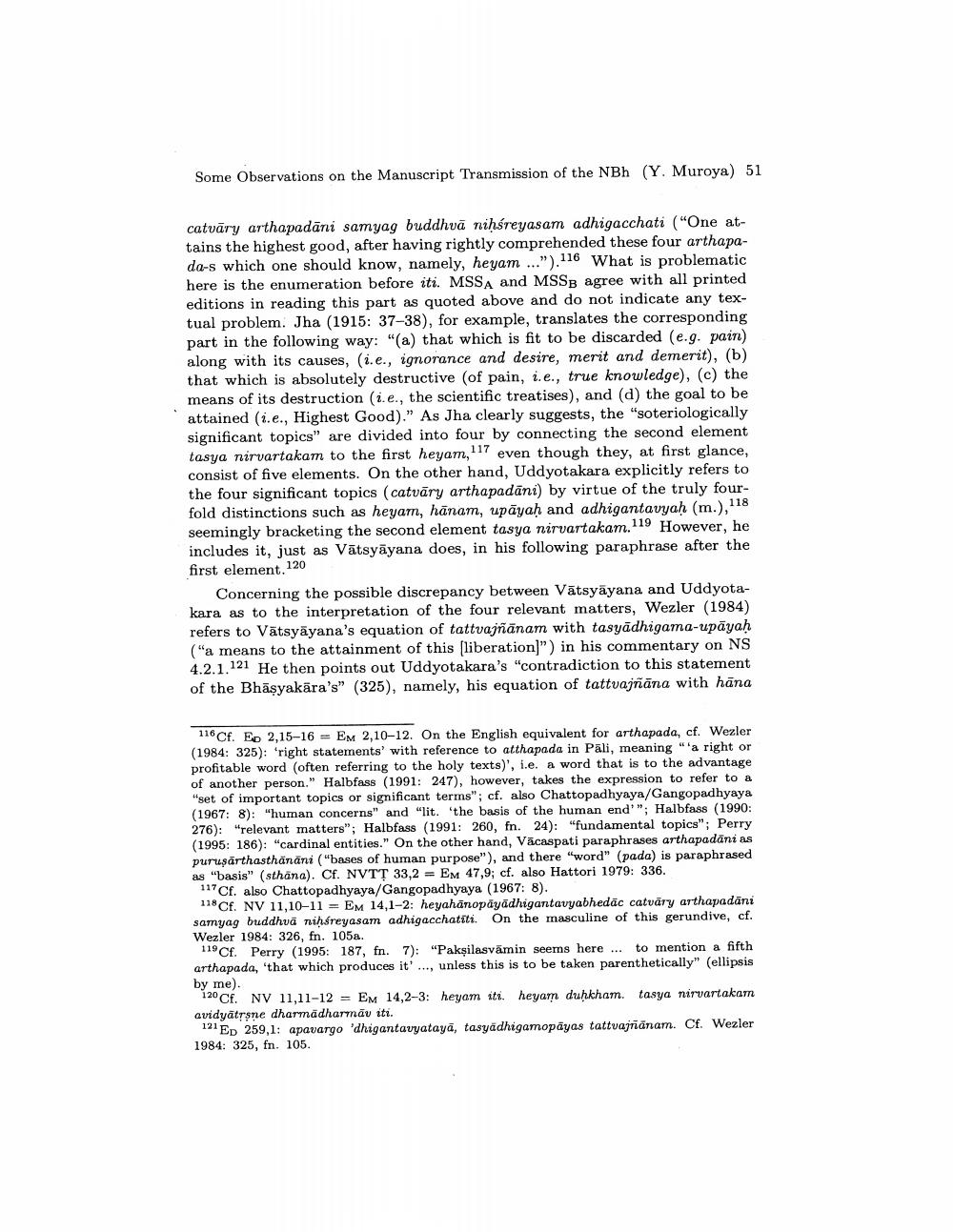________________
Some Observations on the Manuscript Transmission of the NBh (Y. Muroya) 51
catvāry arthapadāni samyag buddhvā nihśreyasam adhigacchati ("One attains the highest good, after having rightly comprehended these four arthapada-s which one should know, namely, heyam ...").116 What is problematic here is the enumeration before iti. MSSA and MSSB agree with all printed editions in reading this part as quoted above and do not indicate any textual problem. Jha (1915: 37-38), for example, translates the corresponding part in the following way: "(a) that which is fit to be discarded (e.g. pain) along with its causes, i.e., ignorance and desire, merit and demerit), (b) that which is absolutely destructive (of pain, i.e., true knowledge), (c) the means of its destruction (i.e., the scientific treatises), and (d) the goal to be attained (i.e., Highest Good)." As Jha clearly suggests, the "soteriologically significant topics" are divided into four by connecting the second element tasya nirvartakam to the first heyam, 117 even though they, at first glance, consist of five elements. On the other hand, Uddyotakara explicitly refers to the four significant topics (catvāry arthapadāni) by virtue of the truly fourfold distinctions such as heyam, hānam, upāyaḥ and adhigantavyah (m.), 118 seemingly bracketing the second element tasya nirvartakam.119 However, he includes it, just as Vātsyāyana does, in his following paraphrase after the first element. 120
Concerning the possible discrepancy between Vätsyāyana and Uddyotakara as to the interpretation of the four relevant matters, Wezler (1984) refers to Vätsyäyana's equation of tattvajñānam with tasyādhigama-upāyaḥ ("a means to the attainment of this (liberation)") in his commentary on NS 4.2.1.121 He then points out Uddyotakara's "contradiction to this statement of the Bhāṣyakära's" (325), namely, his equation of tattvajñāna with hāna
116 Cf. Eo 2,15-16 - EM 2,10-12. On the English equivalent for arthapada, cf. Wezler (1984: 325): "right statements with reference to atthapada in Pali, meaning "'a right or profitable word (often referring to the holy texts)', i.e. a word that is to the advantage of another person." Halbfass (1991: 247), however, takes the expression to refer to a "set of important topics or significant terms"; cf. also Chattopadhyaya/Gangopadhyaya (1967: 8): "human concerns" and "lit. 'the basis of the human end'"; Halbfass (1990: 276): "relevant matters"; Halbfass (1991: 260, fn. 24): "fundamental topics"; Perry (1995: 186): "cardinal entities." On the other hand, Vacaspati paraphrases arthapadani as puruşarthasthanani ("bases of human purpose"), and there "word" (pada) is paraphrased as "basis" (sthana). Cf. NVTT 33,2 = EM 47,9; cf. also Hattori 1979: 336. **Cf. also Chattopadhyaya/Gangopadhyaya (1967: 8). 118 Cf. NV 11,10-11 = EM 14,1-2: heyahānopayadhigantavyabhedac catvary arthapadani samyag buddhva nifreyasam adhigacchatiti. On the masculine of this gerundive, cf. Wezler 1984: 326, fn. 105a.
11 Cf. Perry (1995: 187, fn. 7): "Paksilasvāmin seems here ... to mention a fifth arthapada, 'that which produces it' ..., unless this is to be taken parenthetically" (ellipsis by me).
120 Cf. NY 11,11-12 = EM 14,2-3: heyam iti. heyam duhkham. tasya nirvartakam avidyātrsne dharmādharmāv iti.
121 Ep 259,1: apavargo 'dhigantavyatayā, tasyadhigamopāyas tattvajñānam. Cf. Wezler 1984: 325, fn. 105.




